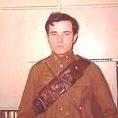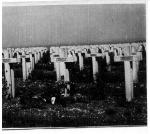-
Posts
1,784 -
Joined
-
Last visited
-
Days Won
3
Content Type
Profiles
Forums
Blogs
Gallery
Events
Store
Everything posted by Michael Johnson
-
I was lucky - when my great-uncle died I got his, and his gas mask, and his L?gion d'Honneur.
-
That's not a Morass, it's the Golden Ho(a)rd(e).
-

M1917 American Enfield question.
Michael Johnson replied to Hun Helmet's topic in Firearms & Ordnance
The P1917 was sent over in some numbers for the Home Guard in 1940. It was also used for training in Canada, and I think by the R.C.A.F. as well. -

Just what is a STAND of Weapons?
Michael Johnson replied to Kev in Deva's topic in Firearms & Ordnance
I just checked my copy of the Universal Military Dictionary (1779). It defines a "stand of arms" as "a complete set of arms for one soldier" (emphasis mine). It presumably would consist of musket, bayonet, and probably cartouche and belts. So it could be as few as 40 men. I think, on reflection, that this is probably the correct use here. -

Victoria Cross...
Michael Johnson replied to Thierry's topic in Great Britain: Orders, Gallantry, Campaign Medals
Quite a lot out there. Try this Google search. He was not a civilian at the time, or he would not have been eligible for the V.C. -

Just what is a STAND of Weapons?
Michael Johnson replied to Kev in Deva's topic in Firearms & Ordnance
In 1830 we're still talking flintlock muskets. My memory's getting dim after thirty years, but at Old Fort York we piled our Besses in threes, interlocking the ramrods. Later, the Lee-Enfields had a "piling-swivel" (like a sling swivel with the bar cut out, that at least in theory would have allowed multiple rifles to be piled. "which in your case you have not got." Naming of parts -
"R.B." stands for The Rifle Brigade. Both the 1st and 2nd Battalions were present. The Rifle Brigade carries battle honours for Alma, Inkerman, and Sebastopol. If I recall correctly (my copy of Gordon is at home) a number of infantry received "Balaklava" although it was primarily (apart from "the thin red line" of 93rd Highlanders) a cavalry action.
-
I think a better scenario is: TTHUNK!!! "Was ist los? "Ein franzische panzer, Herr Leutnant!" With maybe a German soldier peering through the tall grass, like Arte Johnson used to do on Laugh-in. "Verrry interesting." Maybe the title "Memento Mori".
-
I agree. I've always like "relics" as a subject (someday I will do my Avro Anson trainer sitting in a Saskatchewan farmyard). My only quibble is how likely would it be for a French tank to sit in a farmhouse for 25 years without someone finding it? More likely would be a new growth forest, perhaps "out of bounds" because of unexploded ordnance. Maybe nose down in a shell hole for a lower profile. There is supposed to be a Canadian tank in Normandy which went into a stream up to the turret ring.
-

Pair + condolence slips etc.
Michael Johnson replied to Tony's topic in Great Britain: Orders, Gallantry, Campaign Medals
I think TNT might be the culprit Effects of TNT -
There is a series of Indian government publications called "Frontier and Overseas Expeditions from India" done at the beginning of the last century. They are regionally based, i.e. all the expeditions against one group of tribes, or one country (Burma). Some of them are available for download www.archive.org. I bought the set in an Indian reprint about 20 years ago. First part is a description of the area and its people (for the next expedition, no doubt), followed by the details of the expeditions. Quite detailed in most cases (number of men from each unit), casualties (not by name). I'm at work now, so I can't tell you which volume you need.
-
What's the reverse on the Wound Medal? Isn't it the chakhra as well?
-

Father-in-Laws RN Medals
Michael Johnson replied to Humber's topic in Great Britain: Orders, Gallantry, Campaign Medals
The tonal values of my work computer leave something to be desired On my home computer I can see the red stripes. -

Father-in-Laws RN Medals
Michael Johnson replied to Humber's topic in Great Britain: Orders, Gallantry, Campaign Medals
A very nice group indeed. One small point is that the last medal appears to be the Royal Fleet Reserve Long Service Medal, judging by the ring suspension, and the ribbon on his ribbon bar, but you were given Royal Navy Long Service and Good Conduct Medal ribbon. Easy enough to fix. The other medal he did not apply for is almost certainly the Russian 40th Anniversary of the end of the Second World War (or the Great Patriotic War, as they call it). I mounted up a R.C.N.V.R. group which belonged to one of my father's law partners, and it included that medal. I believe that the Soviet Government awarded it to quite a a few Commonwealth sailors who had been involved in the Murmansk run. This article Murmansk Medal suggests that you may still apply for it. I'm sure it applies equally to Commonwealth sailors, although you would apply to the local Russian Embassy. -
I put this one to a retired career Marine who I know from another Forum. Here is his reply: Not conclusive, but it adds some additional points.
-
Description Medal card of Croucher, Henry Corps Regiment No Rank Army Service Corps M2/055307 Private Army Service Corps M2/055307 Private Date 1914-1920 Catalogue reference WO 372/5 MIC uses a "/" instead of a "-" I don't trust wildcards in some database searches. Kev, from here go to www.nationalarchives.gov.uk/documentsonline, and click on the link at right WWI Campaign Medals. Using the information we've provided you can purchase copies of the Medal Index Card, which will tell you what medals each man qualified for. If they served before 1916 it will also usually give the date they entered a theatre of war, and which one.
-
Not difficult. Corporals in the Engineers named Martin, then I found T838 which tied it all together. It's too easy to make a mistake in a regimental number. I can't explain Vincent's number on the medal, but the discrepancy between the MIC and CWGC is very easy: a 4 was read as a 9 or vice-versa. Easy enough if the roll was handwritten.
-
Took a little creative searching, but: Description Medal card of Martin, Leslie W Corps Regiment No Rank Royal Engineers T838 Corporal Royal Engineers 540180 Corporal Date 1914-1920 Catalogue reference WO 372/13 And Description Medal card of Vincent, Gordon S Corps Regiment No Rank Yorkshire Light Infantry 23543 Private Yorkshire Light Infantry 23543 Corporal Date 1914-1920 Catalogue reference WO 372/20 No, I can't explain the discrepancy in the number, but the other parameters match. And even more confusing is this CWGC entry: 23593 Gordon Stoodley Vincent And the only Gordon S. Vincent born 1880-1899 is Gordon Stoodley Vincent Also, I'm pretty sure the number is 6th KOYLI, since I have recently been researching William Carney who served in the 6th Bn.
-

Can anyone help with this cemetery?
Michael Johnson replied to Michael Johnson's topic in The Great War 1914 to 1918
Sepultures de Guerre responded to my request very promptly, but they have no record of any grave within their charge. They point out that this is usually the case where the family re-interred the body in the family plot. Which of course is a lesson in overcoming mindset. For a Commonwealth researcher we tend to start with two assumptions: a. All war dead are in war cemeteries, on war memorials, or have a government headstone if in a private cemetery (although I know of cases in Canada where this is not the case). b. War dead are buried where they died. The French obviously did not have rules similar to Commonwealth War Graves. Repatriating a grave simply meant at most a few hours drive. And if Antonin was buried in a German cemetery, you can see why he was moved. I'm following up with the mairies of Chaponost and Oullins. -
Jildi (jaldi) - quickly chota - small burra - big
-
It should be remembered that the Canada General Service Medal wasn't authorized until the 1890s. And it took incredible lobbying by the Canadian government to get the North West Canada Medal in 1885, H.M.'s Government replying that it was not customary to issue medals for "local uprisings". The rebellions were followed by a period where the rebels, aided and abetted by Americans who wanted to replay the War of 1812, raided into Canada.
-
[attachmentid=29544] This is a photo of my cousin Adjt. Antonin Gautier's grave. It is not recorded in the Sepultures de Guerre database. There is a family tradition that the family was given a safe conduct to visit the grave, as it was behind German lines. Can anyone tell from the style of grave markers whether this is in fact a German cemetery? Unfortunately the names are not clear enough to read. But they are very different from the ones below, which are definitely French. [attachmentid=29545]
-
I haven't been able to find a match for the badge, although a number of French North African units used the crescent. Bugle playing is an art. The sound is not cused by your breath going through the bugle, but by the vibration of your lips against the mouthpiece as you blow.



